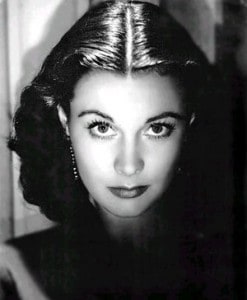“Her Scarlett O’Hara and Blanche DuBois . . . remain so powerful today because she revealed herself in each of these characters, and in doing so gave us a realistic glimpse into the human condition.”—-Author’s Epilogue
In Kendra Bean’s new semi-biography cum-picture book, Vivien Leigh, An Intimate Portrait, the latest but by no means the last book on Vivien Leigh, the reader is almost immediately confronted by the rather daunting beauty of the actress in a photograph—double-page here—taken in her prime by M-G-M photographer Laszlo Willinger. In the picture is the confident and seductive gaze, but also her most beguiling feature—her eyes, which, if the picture were in color, would show green.
This overwhelming beauty that seduced many a man in any number of ways, belies the almost animal, catlike and sometimes predatory, strength that powered the two halves of her life. The first was the professional half, the struggle, unsuccessful, to top her performance in and the fame of Gone With the Wind; the second was the personal half, the drive, with mixed results, to possess, keep and still love—after the passion had died—the focus of her life, Laurence Olivier.
In her glossy, thick-leafed book, Bean spends only twenty-seven pages—remembering that at least half of those are photographs—on Vivien’s first twenty-five years, a little less than half her life, for this is primarily a picture book, a celebrity coffee table book, and for Vivien real celebrity came at twenty-six. When seven, she told her nine-year-old friend Maureen O’Sullivan that she wanted to be an actress, and at twenty-two her wish began coming true when she created a sensation in her second London play, an English translation of Carl Sternheim’s The Mask of Virtue.
So author Bean quickly makes ready for Vivien’s high points, the signposts of her fame and notoriety.
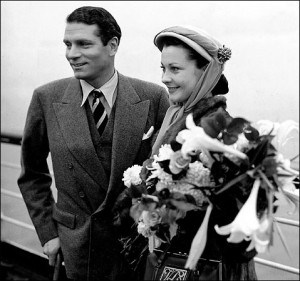 Lying in wait for her future—for good and ill—came this man in her life. Contrary to the assumed belief that she first met Olivier on a movie set, Vivien initially encountered him in the restaurant of the Savoy Hotel, London. Having just seen her in The Mask of Virtue, Olivier was electrified by her beauty, but, as Bean writes, “he confessed to not thinking much of her abilities as an actress at the time.” And this might have been a dark secret in their relationship, an underlying wrinkle never consciously acknowledged, that Olivier’s enormous ego could never regard her as his acting equal, let alone his superior.
Lying in wait for her future—for good and ill—came this man in her life. Contrary to the assumed belief that she first met Olivier on a movie set, Vivien initially encountered him in the restaurant of the Savoy Hotel, London. Having just seen her in The Mask of Virtue, Olivier was electrified by her beauty, but, as Bean writes, “he confessed to not thinking much of her abilities as an actress at the time.” And this might have been a dark secret in their relationship, an underlying wrinkle never consciously acknowledged, that Olivier’s enormous ego could never regard her as his acting equal, let alone his superior.
Near the end of his life, Olivier still vividly remembered the first sight of her: “Except for seeing her on the stage, it was the first time I ever set eyes on that exquisite face. Yes, she saw me, too. But she was with a young man who looked very much in love, and I supposed that they were, to put it vulgarly, ‘at it.’ ” Vivien was always having affairs, and a point not clearly defined in this book was her nymphomania. Her lover that day at the luncheon table, though she was still married to Herbert Leigh Holman, was John Buckmaster, Gladys Cooper’s son.
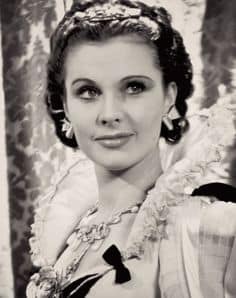 About this time came Fire Over England, the first of the three films Vivien and Olivier would make together. The story line was centered around Flora Robson as Queen Elizabeth I, and Raymond Massey, Leslie Banks and Olivier himself had larger roles that Vivien’s. But producer Alexander Korda sensed the magnetism between his two young stars and played that up in his publicity for the film. This might have been unnecessary, for the magnetism on screen between Vivien and Olivier was quite palpable and, practically overnight, they became the screen lovers of the day, certainly in England.
About this time came Fire Over England, the first of the three films Vivien and Olivier would make together. The story line was centered around Flora Robson as Queen Elizabeth I, and Raymond Massey, Leslie Banks and Olivier himself had larger roles that Vivien’s. But producer Alexander Korda sensed the magnetism between his two young stars and played that up in his publicity for the film. This might have been unnecessary, for the magnetism on screen between Vivien and Olivier was quite palpable and, practically overnight, they became the screen lovers of the day, certainly in England.
Strange. As scripted by David Thomson in the 1988 documentary “The Making of a Legend: Gone With the Wind,” David O. Selznick, when viewing Fire Over England during his search for Scarlett, “couldn’t see the fire beneath the Elizabethan costumes.”
Twenty-One Days Together was the second movie the two stars made together—this in 1937, but Korda thought so little of it—and it isn’t a good film—that he withheld its London and American releases until 1940.
Sidewalks of London was Vivien’s last film and Serena Blandish her last play before she left for the U.S., determined to play Scarlett. She had read the book several times and saw herself as the natural and obvious—the only—choice for the strong-minded heroine. “Everybody said I was mad to try for Gone With the Wind,” she said later in 1960, “but I wanted it and I knew I’d get it.” It was only when Selznick met her during the filming of the burning of Atlanta—and saw that first screen test—that he knew he had found his and Margaret Mitchell’s Scarlett.
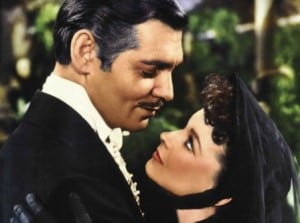 Two weeks after filming began in February, 1939, the director, George Cukor, abruptly withdrew from the movie. The reason has never been clear. Even Cukor admitted years later to be mystified himself, a strange admission for so intelligent a man. Rumor had it that Vivien’s co-star Clark Gable resented this “woman’s director” who was supposedly favoring the ladies, Vivien and Olivia de Havilland, who was playing Melanie. More likely, Selznick was displeased with the slow pace he saw in the rushes and replaced Cukor with his opposite, a “man’s director,” Victor Fleming, and, coincidentally, Gable’s buddy. This change did considerably quicken both the screen’s pace and the amount of filming done per day. Although others directed isolated scenes—Sam Wood and William Cameron Menzies among them—Fleming received sole screen credit. Cukor’s work remained in the film.
Two weeks after filming began in February, 1939, the director, George Cukor, abruptly withdrew from the movie. The reason has never been clear. Even Cukor admitted years later to be mystified himself, a strange admission for so intelligent a man. Rumor had it that Vivien’s co-star Clark Gable resented this “woman’s director” who was supposedly favoring the ladies, Vivien and Olivia de Havilland, who was playing Melanie. More likely, Selznick was displeased with the slow pace he saw in the rushes and replaced Cukor with his opposite, a “man’s director,” Victor Fleming, and, coincidentally, Gable’s buddy. This change did considerably quicken both the screen’s pace and the amount of filming done per day. Although others directed isolated scenes—Sam Wood and William Cameron Menzies among them—Fleming received sole screen credit. Cukor’s work remained in the film.
With Cukor’s departure, so went any enjoyment Vivien might have had in the filming. A definite consolation was her receiving an Oscar as Best Actress for Scarlett.
After much indignation among critics and movie fans that an English girl had been selected to play a Southern belle, when the results were seen on screen, how Vivien took over the part so convincingly, opinion somersaulted the other way. Following the premiere in Atlanta at the end of 1939, praise came in from all over the world, but author Mitchell seemed to have summed it up better than any long, effusive review. “She is my Scarlett,” she said. What better approval was needed?
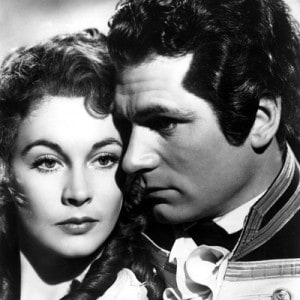 Just before filming began on Vivien’s last film with Olivier, That Hamilton Woman, she having been divorced from Holman since February of 1940, the couple eloped and were married in a secret ceremony in Santa Barbara, California, August 30, 1940, two days after Olivier’s own divorce decree from Jill Esmond had become final. Garson Kanin and Katharine Hepburn were best man and maid of honor.
Just before filming began on Vivien’s last film with Olivier, That Hamilton Woman, she having been divorced from Holman since February of 1940, the couple eloped and were married in a secret ceremony in Santa Barbara, California, August 30, 1940, two days after Olivier’s own divorce decree from Jill Esmond had become final. Garson Kanin and Katharine Hepburn were best man and maid of honor.
The newlyweds soon returned to England—to London in the middle of an air raid—and began some stage work and doing their bits for the war effort. Vivien’s appearance in George Bernard Shaw’s The Doctor’s Dilemma was a substantial success. Two months after the opening of Thornton Wilder’s The Skin of Our Teeth, shortly after VE Day in May of 1945, she was diagnosed with tuberculosis, which she had had as a child. After a short stay in a London hospital, she spent the rest of her convalescence at the couple’s newly purchased home in Buckinghamshire, a twelfth-century monastery, Notley Abbey.
A year or so later the first symptoms of manic depression, now known as bipolar disorder, began to manifest themselves—mood swings, abusive temper, glaring looks and, of course, acute depression. As far back as 1937, Alec Guinness remembered whispers about her mental health: “I never saw cruelty or coldness in Vivien—even her ambitions and her needs were dealt with charmingly and sweetly . . . She appeared, at a very young age, to turn into a lovely stalk of chalk, and the chipping away had begun, and you were there to see the flaking off.”
